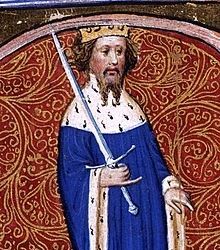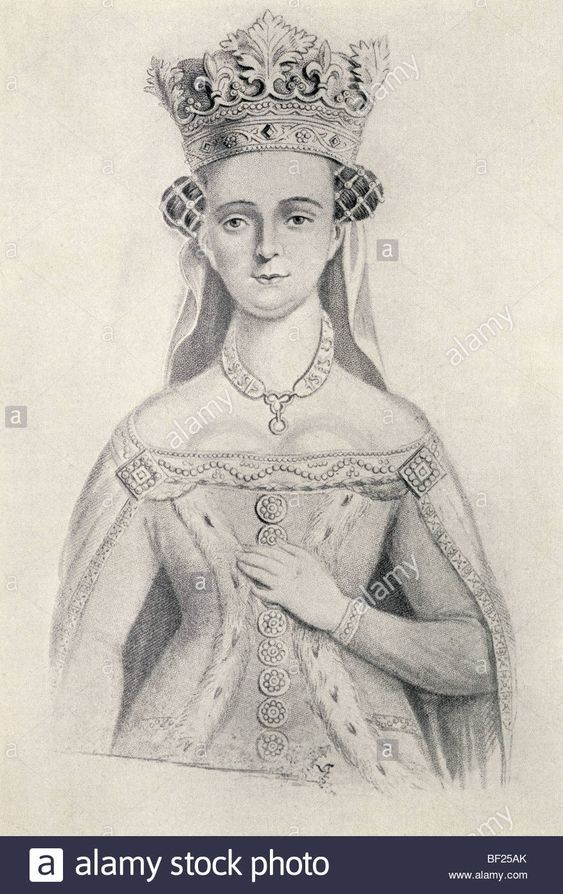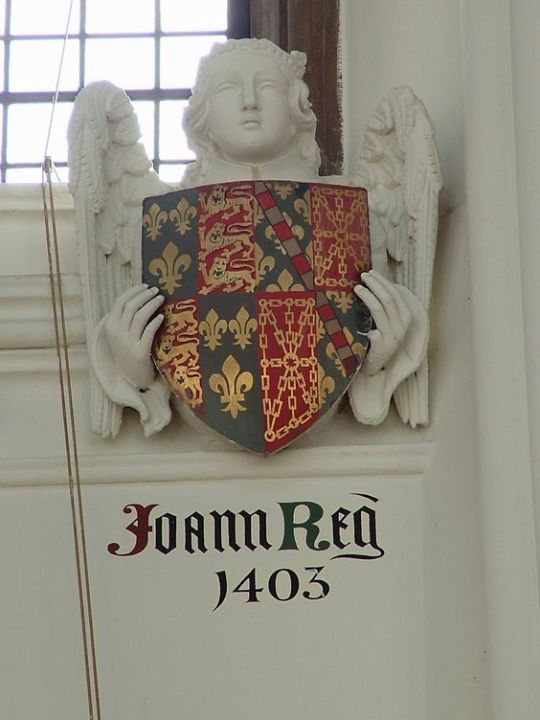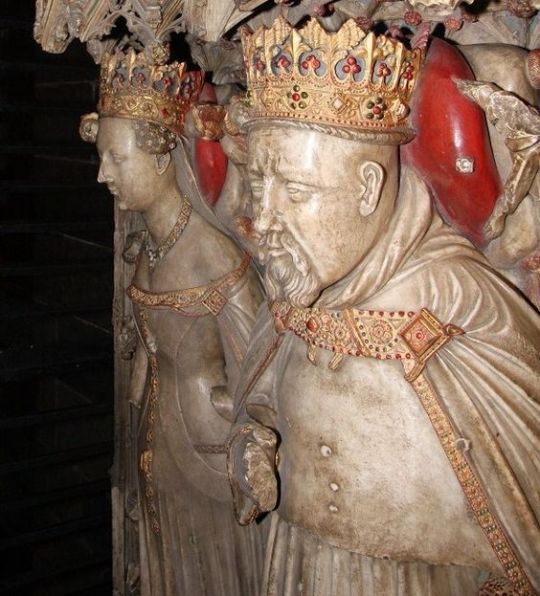#jeanne d'evreux
Text

On this day in History, 10 June 1432, Jeanne d'Évreux, daughter of Navarre, died at Havering-atte-Bower. She was formerly Duchess of Brittany by her first marriage, and Queen of Enfland by her second marriage, which was a love union. Despite being imprisoned for some years by her stepson, Henry V, Joan (as she was better known by her English subjects) still received visits from her stepchildren such as Humphrey of Gloucester and John of Bedford, but more often her Beaufort in-laws like Cardinal Beaufort. She was buried next to Henry.
#house of lancaster#house of evreux#jeanne d'evreux#joan of navarre#henry iv of england#queen joan#dowager queen of england#dowager duchess of brittany#plantagenet dynasty
12 notes
·
View notes
Text

Is that a badger with an axe?
51 notes
·
View notes
Photo

Tomb Plaque of Blanche of France (1328–92), daughter of Charles IV of France and Jeanne d'Evreux. after 1392. Credit line: The Cloisters Collection, 1925 https://www.metmuseum.org/art/collection/search/472540
#aesthetic#art#abstract art#art museum#art history#The Metropolitan Museum of Art#museum#museum photography#museum aesthetic#dark academia
2 notes
·
View notes
Text






Midjourney created Star Wars in the style of the Book of Hours of Jeanne d'Evreux.
4 notes
·
View notes
Text

Jean Pucelle, The Hours of Jeanne d'Evreux, Queen of France: fols. 15v-16, The Arrest of Christ and the Annunciation, c. 1324-28 (The Cloisters Collection, NYC)
[For those who have never seen this in person at The Cloisters, it's so tiny it fits inside of your cupped palms.]
3 notes
·
View notes
Photo










the daughters of jeanne ii and philip iii of navarre
↳ requested by anonymous
#historyedit#perioddramaedit#documentaryedit#history#French History#navarrese history#Spanish History#jeanne of navarre#marie of navarre#Blanche of Navarre#agnes of navarre#jeanne d'evreux#marie d'evreux#blanche d'evreux#agnes d'evreux#our edits#by nadz#gif
166 notes
·
View notes
Text
Team Jeanne d’Evreux badge

Team Jeanne d'Evreux 6 Cm Round Badge
by
CreativeHistory
#Jeanne d'Evreux#Queen Jeanne#Queen of France#French Queen#French history#royalty#monarchy#14th century#Charles IV#medieval women#Capet#Capetian
0 notes
Photo


Tomb Effigy Bust of Marie de France (1327-41), daughter of Charles IV of France and Jeanne d'Evreux.
Artist: Jean de Liège (Franco-Netherlandish, active ca. 1361–died 1381)
Date: ca. 1381
Place of origin: Made in Île de France
Culture: French
Medium: Marble with lead inlays.
#14th century#tomb effigy bust#marie de france#daughter#charles iv of france#jeanne d'evreux#jean de liége#ca. 1381
254 notes
·
View notes
Photo




The Met Cloisters - Fort Tryon Park - 99 Margaret Corbin Dr, NY 10040
Discover the wonders of medieval Europe through the art, architecture, and gardens found at The Met Cloisters. Enjoy unparalleled views of the Hudson River, stroll through enchanting gardens and see masterpieces of medieval sculpture, stained glass, tapestries and more. The Met presents over 5,000 years of art from every corner of the world for everyone to experience and enjoy. Beside The Met Cloisters, the Museum lives in two other iconic sites in New York City - The Met Fifth Avenue and The Met Breuer.
└─► The Met - Official
└─► The Met Cloisters | The Metropolitan Museum of Art
└─► The Met Media Video ***
#manhattan#west manhattan#the cloisters#fort tryon park#Washington Heights#european medieval architecture#medieval artworks#french monasteries#charles collens#medieval European monastic life.#byzantine#byzantine periods#the met fifth avenue#the met breuer#the met cloisters#cloisters apocalypse#hours of jeanne d'evreux#tapestries#stained glass#hudson river#bonnefont garden#illuminated manuscripts#panel paintings and sculpture#john d. rockefeller jr#the cuxa cloister#gothic chapel#fuentidueña chapel#langon chapel#romanesque hall#metropolitan museum of art
333 notes
·
View notes
Photo




“Henry's relationship with the widow Joan of Navarre was one of the real surprises of his reign. She was the same age as him, the daughter of Charles the Bad, king of Navarre, and Joan de Valois, daughter of King John II of France. Thus she was Henry's third cousin twice over.
By her previous husband, the duke of Brittany, she had eight children. Following the duke's death, she had acted as regent in Brittany during the minority of her eldest son. She was not just a Navarrese princess, she was an import ant member of the French royal family.
Such a match was bound to cause shock waves in so ciety, on both sides of the Channel. England was on the verge of war with France, and had been since the revolution. As recently as November 1401 the council was considering the question of how ‘to counter the malice of those of France who wanted war'. Such was the fear that it was deemed necessary to summon a great council to discuss the matter in January. Henry accordingly kept his discussions about the marriage secret. Nevertheless, he could hardly conceal the presence of Navarrese ambassadors at his court.
When his council asked what the ambassadors had come to talk about, he would say only that they would be told in due course. Although it is not known when Henry and Joan first met, they were probably already acquainted when Henry travelled to France for the celebrated meeting at Ardres in 1396 and the subsequent royal wedding at Calais.
On that occasion he stayed almost a month in France, and had several opportunities to see her. They would have met again at the Garter feast at Windsor in April 1398, which Joan attended with her husband. It is likely that they met again during Henry's exile, when his marriage to Mary of Berry was being discussed.
No marriage at this stage was possible, of course, as the duke of Brittany was still alive. But after the old duke's death in November 1399 it seems that the idea swiftly entered Joan's mind, if not Henry's too. Within three months she sent ambassadors to Henry, and on 15 February 1400 wrote him a letter which is almost intimate in its expression of good wishes:
‘My most dear and honoured lord and cousin,
Forasmuch as I am eager to hear of your good estate -which may our Lord make as good as your noble heart. For whenever I am able to hear a good account of you, my heart rejoices exceedingly.
And if, of your courtesy, you would like to hear the same from over here-thank you-at the time of writing my children and I are all in good health (thanks be to God, and may He grant the same to you) as Joanna de Bavelen, who is bringing these letters to you, can explain more plainly...
And if anything will please you that I am able to do over here, I pray you to let me know; and I will accomplish it with a very good heart according to my power. My most dear and honoured lord and cousin, I pray the Holy Ghost that He will have you in his keeping.
Written at Vannes, 15 February, the duchess of Brittany’
The tone of this letter leaves no doubt that there was a genuine closeness between Henry and Joan. It goes far beyond the usual politeness between a member of the French royal family and the king of England, especially considering that it was written a few days after the English ambassadors at Calais had warned Henry that war with France was more likely than peace.
But there is more here to suggest a genuine closeness. Intimacy is the sole purpose of the letter: apart from its kind thoughts, it says nothing of consequence. It implies-in Joan's thanks to Henry for asking after her health-that he had already written a letter to her. And it reveals that Joan, like Henry himself, was a believer in the power of the Trinity (as shown by the reference to the Holy Ghost).
They were more than just friends; they shared a spiritual outlook.Their courtship was conducted in secret and from afar. Ambassadors conveyed their communications to each other, never putting anything in writing as sensitive as the above letter.
The obstacles to their relationship were not just limited to the likelihood of war between their countries and the disapproval of the French Crown. France recognised the pope at Avignon, Benedict XIII; the English recognised the Roman pontiff, Boniface IX. In order for Henry and Joan to marry, they had to obtain a dispensation, as they were related within the degrees of consanguinity prohibited by the Church. Not until 20 March 1402 did Joan obtain a bull from Pope Benedict allowing her to marry Henry. Immediately she empowered her ambassadors, Antony and John Rhys, to arrange the ceremony. They did so with great speed.
She was married to Henry by proxy just two weeks later, at Eltham, on 2 April 1402. Present to witness proceedings were Henry's half-brother, John Beaufort, and several of his closest friends, including the archbishop of Canterbury and all three Percys, namely the earls of Northumberland and Worcester, and Hotspur.
The form of words used on this occasion included 'thereto I plight thee my troth', the first recorded appearance of the well-known phrase. Marriage was just the beginning of the struggle. As soon as the deed was done, Henry had to explain to his kingdom why he was marrying a Frenchwoman at this particular time. The English people were astonished.
For her part, Joan had to arrange with the rest of the French royal family how she could marry their enemy: the man who had ousted King Charles's son-in-law and thus deprived his daughter of the throne of England. She also had to persuade Benedict XIII to grant her permis sion to live among schismatics (those who supported his papal rival).
But Joan was a resourceful and determined woman. Henry too had made up his mind.These problems show that this was far from being a marriage of convenience. So it is likely that it was yet another royal love affair, like so many royal partnerships in the late middle ages. Yet all royal marriages have a political dimension, however emotionally and spiritually close the couple may have been.
In Henry's case this is made clear by simultaneously arranging his two daughters' marriages as well as his own. Blanche was already betrothed to the son of the Holy Roman Emperor, and was about to set out for the Rhineland; and Philippa's hand was the subject of discussion between Henry and the king of Denmark. These multiple negotiations indicate that Henry was looking at connections with ruling houses not just to cement alliances with other countries but in order to achieve a wider recognition of his dynasty. If he could persuade everyone else in Europe to accept him as the rightful king of England, and if he himself could marry a French duchess, how much longer could the French refuse to recognise him as king of England? [...]
Henry had at last found in his new wife the sort of companionship he had lost with Mary's death, nearly nine years before. In the early years of his reign we find occasional references to his pastimes--sword-fighting and hunting, and even an idiot or fool--but other wise his time was heavily employed in the relentless business of state.
There was precious little time for enjoyment, and only a handful of trusted old friends with whom to spend it. Now he had a constant, intelligent and trustworthy companion. She was passionate and determinedly loyal. She was also a woman with whom Henry could discuss business. Joan had, after all, managed the affairs of the duchy of Brittany.
The following year Henry granted her a tower at Westminster in which to maintain an office. The business she took on in cluded holding councils, handling and auditing accounts, and keeping charters and similar documents. She was clearly a hands-on sort of woman, more inclined to administrative duties than needlework. In that, too, she seems to have been a good match for the king.”
[MORTIMER, I. “Henry IV: The Righteous King.”]
#Joan of Navarre#Jeanne de Navarre#Jehanne de Navarre#Duchesse de Bretagne#Duchess of Brittany#Queen of England#Queen Joan#Queen Joanna#Joanna of England#House of Lancaster#House of Navarre#Jeanne d'Evreux#House of Evreux#Henry IV#Henry of Bolinbroke#Henry Bolinbroke#King Henry IV of England#Henry IV of England
13 notes
·
View notes
Text

Tomb Effigy Bust of Marie de France (1327-41), daughter of Charles IV of France and Jeanne d'Evreux
ca. 1381
Jean de Liège
3 notes
·
View notes
Photo

kill the wabbit
Hours of Jeanne d'Evreux, Paris c. 1324-1328
NY, Met 54.1.2, fol. 16v
#rabbit#hare#medieval art#marginalia#14th century#book of hours#book#illuminated manuscript#manuscript#medieval#art#middle ages
751 notes
·
View notes
Photo

Jeanne d'Évreux, Queen of France.
30 notes
·
View notes
Photo

Tomb of Henry II and his wife Catherine de' Medici with gisant effigies of Philip V of France, Jeanne d'Évreux and Charles IV
0 notes
Photo

15 de Abril de 1764 -- Fallece Jeanne-Antoinette Poisson, duquesa-marquesa de Pompadour y marquesa de Menars, con paridad francesa, conocida como Madame de Pompadour, fue una muy famosa cortesana francesa, la amante más célebre del rey Luis XV, además de una de las principales promotoras de la cultura durante el reinado de dicho rey. Apasionada de las artes y las letras, la marquesa de Pompadour favoreció el proyecto de la Encyclopédie de Diderot y protegió a los enciclopedistas (se puede ver en su retrato, detrás, algunos tomos de L'Enciclopedie). Dio trabajo a escultores y pintores como Boucher y a numerosos artesanos en la manufactura de porcelana de Sèvres por ella fundada. Organizó, en la corte, toda clase de espectáculos, protegió a los escritores, aprendió a grabar, sabía bailar y tocar el laúd (se la puede ver retratada en la pintura de arriba con una partitura en la mano y un laúd en el fondo). Supervisó la construcción de monumentos tales como la Plaza de la Concordia y el Pequeño Trianón. Poseía varios palacios y castillos, entre los cuales, como residencia parisina, el Hôtel d'Evreux, mucho más conocido ahora bajo el nombre de Palacio del Elíseo. Varias leyendas rodean el personaje de la marquesa de Pompadour. Se dice que tenía una verdadera pasión por la sopa de trufas y apio bañados en tazas de chocolate ambarino «calentando los espíritus y las pasiones». Además propició el consumo del champán el cual decía que aumentaba su belleza. Se dice que la forma de la primera copa de champán fue modelada basándose en la del pecho perfecto de la marquesa. En un ámbito diferente, Madame de Pompadour, tratando de consolar el rey después de la derrota de Rossbach, hubiera hecho esta observación quedada famosa : «Au reste, après nous, le déluge.» («Por lo demás..., después de nosotros, que caiga el Diluvio...»). El 15 de abril de 1764, agotada por veinte años de vida en la corte, se apagó en Versalles, a la edad de 42 años. Viendo la lluvia en el momento de la salida del ataúd de su amante de Versalles, Luis XV dijo esta cínica frase: «La marquise n'aura pas beau temps pour son voyage.» («La marquesa no tendrá buen tiempo para su viaje.»). #Pompadour https://www.instagram.com/p/CNs6TX8hQt4/?igshid=pdc0oehp106b
0 notes
